Music I’ve bought in November.
) | ) | 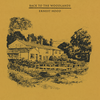 | ) |  |
 | ) | 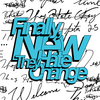 |  |  |
 | ) |  |  |  |
 |  | 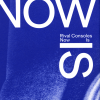 | ) |  |
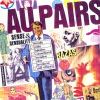 | 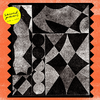 | ) | %3A+Let's+Make+A+Hit+Waxing) |  |
 | 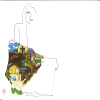 | 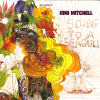 | 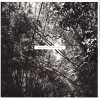 | 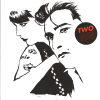 |
 | ) |
Oops! I had a cold, and as is often the case when I’m Suffering So Much From A Light Sneeze, my sleeping patterns got all fucked up. So I thought I had it fixed now — but then I woke up midnight and couldn’t go back to sleep again. Grr.
But I might as well use this night to read some comics, because I got a 20kg shipment yesterday.
Last Comics Daze I bitched and moaned about how the Desert Island Mystery Box was a bit on the… not very obscure side. And another one arrived yesterday, so let’s start with that.
| Boris: Japanese Heavy Rock Hits Live (25th Anniversary Show) |  |
01:32: Burning the Midnight Oil by Daniel Shepard (Desert Island)
What are the odds!
This is a book of illustrations, mostly. It reprints a bunch of zines on newsprint…
I don’t quite get the iconography, but it certainly seems persistent and consistent.
01:42: King Terry Garo Covers
So… this is apparently just what it says on the tin? A collection of King Terry covers for Garo?
Well, OK, fine by me — it’s good stuff, but it feels a bit… weird?
I wish somebody would just inherit a lot of money and start translating Garo to English in full. It seems like more than half of the collections of Japanese comics that are published in English now pilfer Garo anyway, and it’s be more interesting to read the comics in their original context instead.
But anthologies don’t sell, so…
01:54: Environments for controlling people: Best Practices by Deb Sokolow (Desert Island)
This is a very handy manual for constructing optimal architecture.
Very practical.
| Boris: Japanese Heavy Rock Hits Live (25th Anniversary Show) |  |
02:02: Smoke Signal 39 by James Jean (Desert Island)
Is everything this time around published by Desert Island? The Garo book didn’t say one way or another, as far as I could tell…
I like these broadsheet-sized thingies… I’ve only got a smattering of Smoke Signals, and the format seems to encourage illustration over comics?
And this is another collection of illustrations, which makes three of the four books in this mystery box. But it’s very pretty.
So that brings us to the end of the mystery box. It was a lot more mysterious than the previous box, which I really like, so I think I’ll keep my subscription going.
02:10: Breakfast #1-2 (Kobayashi Books)
This is a tabloid-size anthology published in Mexico, if I read the indicia correctly? I don’t speak Spanish, but I think I managed to make that out…
There’s one longer sequence, but the rest of the books are one pagers only. Which is OK, but some of the bits make me wonder whether they’re excerpts from longer works, like the thing to the right.
It’s mostly illustrations, again, but perhaps one quarter of the pieces are comics.
Wow, that’s a nice poster in the middle of the book.
Anyway, these are good reads. There’s a handful of pieces in Spanish, but the rest are either wordless or in English.
02:21: Six Hundred and Seventy-Six Apparitions of Killoffer (Typocrat)
Wow. This was published almost two decades ago, but I haven’t stumbled upon a copy, although I’ve read good stuff about the book. I got this copy from Domino.
This is absolutely totally amazing. It’s a comics reading experience like no other. It’s got an insane flow going on, and the story even makes sense — branching off new Killoffers on every bad impulse.
Fantastic.
| They Hate Change: Finally: New |  |
02:42: The Joy of Quitting by Keiler Roberts (Drawn & Quarterly)
Cool. I’ve been a fan of Roberts since the first minis, and this is a hefty book. I’m guessing that this is gonna be less a collection of vignettes (as usual) and more a single narrative?
Oops. It’s the opposite what I thought it would be — it’s a collection of older work. And I think I’ve got all of those books? Except possibly Rat Time? Well, I’ll read it anyway…
Roberts’ early work was all one-page amusing almost-not-even-an-anecdote stuff, and read so well in those smaller books. And I’m enjoying re-reading them here now, and I know that the stories are going to get more substantial (and longer) as time passes, but I think I’d be slightly discouraged if I was reading this for the first time — the thought of 250 one-pagers like this is exhausting.
But I mean, it’s all funny (and sometimes scary), and the storytelling is on point.
| Ernest Hood: Back to the Woodlands | 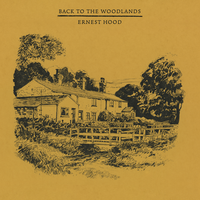 |
There’s certainly a cumulative effect to reading these strips, but I have to say I preferred reading them in the original (smaller) books. I’m totally exhausted now.
| Xiu Xiu: Lucretia My Reflection |  |
04:29: Career Shop Lifter by Gabrielle Bell (Uncivilized Books)
I’ve read most (all?) of these before on the Patreon, but reading them collected is always a treat. And there’s a signed postcard? Fancy! The signature looks so handsome that it doesn’t look real. Which reminds me:
I picked up this Rachel Cusk book in a bookstore a couple months back, and it turned out to be signed.
Now that’s a real signature.
Anyway, this is lovely as usual. The strips are set in a coffee shop, and she’s drawing the other people there. And we also get the finished drawings.
It’s a fun and interesting book.
| Hyd: CLEARING |  |
05:14: West 2 by John Grund (Uncivilized Books)
This is like real science fiction — which is a rare thing in comics these days. (Lots and lots of fantasy and sci-fi, though.)
I especially like how hushed this book is, and how things aren’t really explained. It feels like a well-realised world.
I’m waiting impatiently for more — it feels like it’s going to be a long story?
| Black Cab: Superhereos (Shan remixes) |  |
05:36: Fish out of Water by Phoebe Mol (Fieldmouse Press)
Ah, right, I think I kickstartererd that Fieldmouse Press thing? So I got four book from them yesterday…
I really enjoy the artwork here.
I have no idea what the book is about, but it’s cool anyway.
| Sacred Paws: Strike A Match |  |
05:41: Now and Other Dreams by Daryl Seitchik (Fieldmouse Press)
I guess all these stories are dreams? It’s a challenging genre, because it’s hard to convey what makes a dream matter when retelling the dream.
I’m not sure Seitchik is quite successful at doing that — most of these pieces don’t feel like real dreams — but it’s an enjoyable read nevertheless.
OK, I think it’s time for a nap. If I nap for three hours and get up at nine, then I can stay up until 23 and my sleeping pattern will be totally fixed. Yah! It’s a plan.
| Rival Consoles: Now Is |  |
10:23: Good Person Trouble by Noëlle Kröger (Fieldmouse Press)
I’m awake! I’m awake!
The storytelling here is unlike anything. It’s got such an oblique flow, but everything is still crystal clear.
Even perhaps a bit too clear, because what’s apparently meant to be a big reveal is obvious from the start. Still, the artwork is so charming, and it has great emotional impact. Really good stuff.
| Johan Berthling: Björnhorn |  |
10:59: Magic Nation #1 by Ellen O’Grady (Fieldmouse Press)
Again, this is really special — it’s about being a kid and really paying attention to stuff. It’s dreamy and engrossing. Fabulous.
I do wish they’d bound this book in a different way, though — the spine is so tight that I’m fighting the book all the time just to be able read it.
| Various: Mute Tonal Evidence 2022 |  |
11:17: Notes from a Sickbed by Tessa Brunton (Graphic Universe)
This is a structurally unresolved book. It starts off with a bunch of introductions, and then a section that’s told in a very choppy way.
The main bulk of the book is great — I’ve never seen anybody explain how living with ME is like in such a vivid fashion. It not only clarifies a lot that I’ve been wondering about, but it’s also a gripping, moving story.
And then it… stops. Endings like that can be very powerful (73% of short stories in Paris Review use this strategy), but here it felt a bit unfulfilling? I mean, in one way it worked well, but I just wanted more — more resolution perhaps, or something.
So I’m kinda ambivalent. The main bulk of the book is really, really good, but…
| Björk: Fossora | 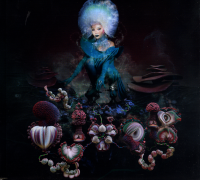 |
12:18: Who Will Make the Pancakes by Megan Kelso (Fantagraphics)
Ooh, new Kelso book…
This is super dense. Kelso packs so much into these pages, but it works.
| Can: Live Cuxhaven 1976 | 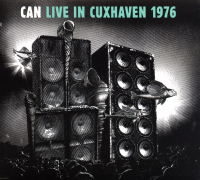 |
But there’s five stories in here, and every one uses a different narrative strategy. It’s a satisfying read.
| Sudan Archives: Natural Brown Prom Queen | 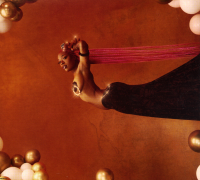 |
13:56: Below Ambition by Simon Hanselmann (Fantagraphics)
This one is focused on detailing a band’s excruciating drunken performances.
It seems to go on forever and ever with pages like this.
But then it shifts and gets all moving and stuff.
And there’s some bits in here that are really funny.
Oh, and a flexi! Let’s put that on… Hey, kinda nice. Twinkly.
OK, I’m comicsed out and I have to run some errands… but that was a nice bunch of comics.
Some years back, I wondered if anybody would step up and maintain, like, a site that lists comics shops worth visiting (when on vacation) and web sites worth visiting when shopping for interesting comics.
That never happened.
So now I’m just gonna start keeping this blog post updated with links and stuff. The first links are just off the top of my head, so I’ll be adding stuff as we go along…
These are shops that I’ve been at (or heard good things about) and have interesting small press stuff.
San Francisco: Comix Experience
Toronto: The Beguiling Books & Art
(This list does not at all attempt to list all comics shops I’ve visited, just the ones with small press/art comics stuff. Google is great at listing mainstream comics stores, but sucks at saying which ones are worth visiting for this kind of stuff.)
Domino Books, the most awesome seller of fabulous comics
These are publishers that have web shops — weirdly enough, most publishers don’t sell directly.
This list includes “international publishers” only, i.e. publishers who publish (some stuff) in English.
If you’ve got stuff to add, please comment on this post and I’ll integrate links.
This is a very odd movie. I guess it’s a romance? It’s set in a hotel right next to a mine, so we’ve got a desolate hotel with almost no guests, booms in the night, and a cast of hotel employees out of Comedy Central Casting.
It’s great!
Ooh! Mysterious stranger!
Tournesols!
Exactly!
This is indeed a very strange movie. It really had something special going on for the first half — that hotel, that mine — but now it’s all dissipated, and instead we’re spending our time at a nearby castle with an insane painter and a smarmy count?
Like er?
I’ve rarely seen a movie take such a hard swerve from being a thing that works to being something that’s more boring than watching gouache dry.
Unfortunately, the movie never recovers from the change of scenery. There’s a bunch of romantic entanglements going on, but none of them are compelling. They’re just… there.
I wonder what happened. It’s almost like the first 40 minutes of this was directed by a quirky but inspired director, and the rest was done by somebody that’s been told to stop messing around and be normal.
The DVD liner notes claims that this movie is “Grémillon most widely admired film”. It was suppressed after a brief run by the Vichy gummint, and I’m wondering whether that has something to do with it. I mean, if a movie has been banned, it automatically gets admirers. On the other hand, I’ve only seen one other film by Grémillon, Remorques, and it quite bad, too, so perhaps “most widely admired” are just weasel words for “Grémillon kinda sucks but this is his least sucky film”?
Finally! The shark!
This is really a ⚁, but the first half hour was special, so:
Summer Light. Jean Grémillon. 1943.
This blog post is part of the Eclipse series.
Heh, this is called Arigatō-san because there’s a bus driver that says arigatō so everybody he passes?
Anyway, I had a hard time watching the previous Shimizu film in this box set just because of technical issues with film stability (OK, it made me nauseous), but this looks fine…
I’m enjoying this a lot already — it seems like it’s really going to be about a bus driver driving around saying arigatō to people? And possibly about the passengers, too.
It’s a low concept movie.
This is lovely — we’re being introduced to all these characters, but there’s no overt plot as such — I think we’re just going to get each character’s mini-melodrama as the film progresses…
This is a really appealing movie. It’s got even less plot going on than I assumed, and I like that a lot. And it’s so un-fusty — the hero of the movie turns out to be the fresh woman who’s plying all the other passengers with likker and insults the old fuddies.
It’s original — I’ve never seen anything quite like this movie. So while it’s not perfect or anything, I really can’t do anything but:
Mr. Thank You. Hiroshi Shimizu. 1936.
This blog post is part of the Eclipse series.